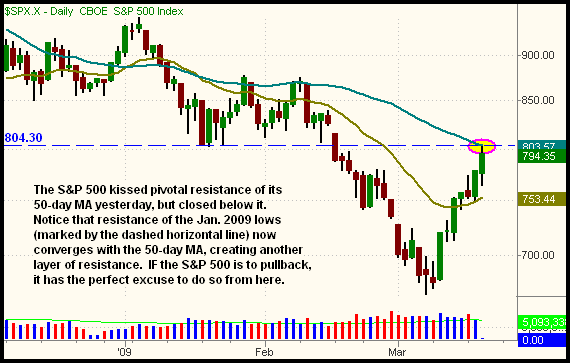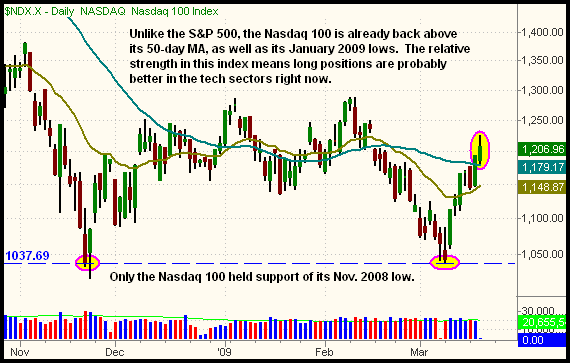|
The Wagner Daily ETF Report For March 19
Stocks logged their sixth day of gains within the past seven sessions yesterday, as market participants reacted favorably to the Fed announcement they would begin buying long-term treasury bonds. The major indices initially got off to a lower start, but again demonstrated their newfound resiliency by recovering back to the flat line by mid-day. Stocks subsequently held in a tight range until the Federal Reserve Board's 2:15 pm ET announcement on economic policy, then rocketed higher immediately thereafter. The S&P 500 advanced 2.1%, the Nasdaq Composite 2.0%, and the Dow Jones Industrial Average 1.2%. Small and mid-cap stocks continued to show relative strength, enabling the Russell 2000 and S&P Midcap 400 to score gains of 3.5% and 3.1% respectively. A pullback in the final hour of trading prevented the main stock market indexes from finishing at their best levels, but they still closed around the upper quarter of their intraday ranges.
More significant than yesterday's gains was the fact that sharply higher volume accompanied the broad advance. Total volume in the NYSE jumped 39% above the previous day's level, while volume in the Nasdaq similarly raced 34% higher. In the Nasdaq, it was the highest volume day so far this year. Notably, about half of yesterday's volume came in the last two hours of trading. Considering the strong post-Fed price action in the broad market, the late-day volume surge was clearly a bullish signal. Volume patterns in the beginning of the week were not encouraging (higher volume losses on Monday, followed by lower volume gains on Tuesday). However, yesterday's broad-based gains on significantly higher volume marked the third "accumulation day" within the past seven sessions. This tells us institutions, such as mutual funds and hedge funds, are becoming increasingly active on the buy side.
Given that the S&P 500 has rocketed 17% higher since its March 9 bottom, one could understandably start to think the market is short-term "overbought." While this may be true on some accounts, it's important to realize overbought markets can continue to become even more overbought before eventually correcting. The same is true of descending markets -- they can remain "oversold" for much longer than one could remain solvent, if aggressively trying to catch a bottom. As a recent example of this, one only needs to think back to last month, to the four-week period from February 10 through March 9. During this time, the S&P 500 logged a gain in only 4 of those 19 days, and plunged a total of 22% before finally managing a significant bounce.
Admittedly, the percentage losses of the stock market's massive losing streak, followed by the equally impressive gains of the winning streak, is unusual by historical standards -- it may be years, or longer, until we such action again. Still, the point is that it's dangerous to make trading decisions based solely on a feeling or technical indicator that says the market is "oversold" or "overbought." Rather, the safest course of action is to always wait for some type of price confirmation that a bounce (in descending markets) or pullback (in ascending markets) is already under way before closing winning positions or entering new ones on the retracement.
So far, the major indices have not exhibited any signs of a pullback from their recent gains. Nevertheless, the reward-risk ratio of entering new positions in the broad-based ETFs at current levels is not very favorable. One major technical reason to wait for a pullback, or at least some decent price consolidation, is that the S&P 500 has run into resistance of its 50-day moving average. This is shown on the daily chart below:

Notice that yesterday's high in the S&P 500 exactly coincided with a kiss of the 50-day MA, an important indicator of intermediate-term trend that is closely followed by institutions. If the stock market is to correct from its recent runup, either through a pullback or price consolidation, key resistance of that 50-day MA gives the market the perfect excuse to do so. However, the bullish side of that argument is that the Nasdaq Composite and Nasdaq 100 indices, both of which showed bullish divergence during last month's sell-off, have already moved back above their 50-day MAs. Looking at the daily chart of the Nasdaq 100 below, notice the index also formed a double bottom at key support of its November 2008 low, unlike all the other major indices. Moreover, it could be effectively argued that the Nasdaq's double bottom was largely responsible for sparking the current rally:

The Nasdaq 100's recent relative strength, along with a slightly less bearish chart pattern, is the reason we bought Ultra QQQ ProShares (QLD) two days ago, rather than ETFs that track the S&P 500 or Dow. Since yesterday's rally pushed our QLD position to an unrealized gain of 8%, we will soon look to trail our stop higher, in order to lock in gains. However, if we set our stop too tight, we won't be able to sit through a normal, short-term correction. There's also new support of the 50-day MA just below QLD, so we're going to keep giving QLD an ample amount of "wiggle room" for now.
Of our other four open positions, USO and SLV finished marginally higher, UGA closed a bit lower, and DGP stopped out. Unfortunately, gold exhibited extreme weakness yesterday morning, causing DGP to hit its stop when it broke support of its prior "swing low" and 200-day moving average. Then, after the Fed announcement, DGP surged parabolically higher and closed at its highest level of the past three weeks! The wild morning selloff, followed by sudden late-day buying frenzy, was indeed a bit frustrating. But such vicious shakeouts are an occasional part of the business one must accept if willing to take on the positive mental attitude of a winning trader. For every time a stop gets nicked right before a reversal, there are an equal or greater number of instances where the stop was not hit, and the trade subsequently went in the right direction. SLV, for example, just missed our stop yesterday, and went on to race higher into the close. As for DGP, we'll keep it on our watchlist to consider for potential re-entry, but we first want to make sure yesterday's final hour strength was not just a short-lived knee-jerk reaction to the Fed meeting.
Open ETF positions:
Long - QLD, USO, UGA, SLV
Short - (none)
Deron Wagner is the Founder and Head Trader of both Morpheus Capital LP, a U.S. hedge fund, and Morpheus Trading Group, a trader education firm launched in 2001 that provides daily technical analysis of the leading ETFs and stocks. For a free trial to the full version of The Wagner Daily or to learn about Wagner's other services, visit MorpheusTrading.com or send an e-mail to deron@morpheustrading.com.
|